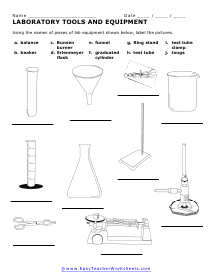This series of worksheets will help students learn their way around a science lab. We will emphasis the important nature of lab safety across these worksheets. We begin by learning all the names of the lab equipment and what each piece is used for. We review the basic units of measurement that you will come across frequently in your experiments. We then look into how to take measures with each of the different pieces of lab equipment this includes using a thermometer, triple beam balance, pan balance, and graduated cylinders. We then explore all the areas of lab safety that students should aware of and have well established procedures for. You will find worksheets that ask you to identify the proper equipment used to measure the value or size of various substances. What lab safety series would be complete without a worksheet on using and measuring with a Triple Beam Balance?
Print Lab Safety Worksheets
Click the buttons to print each worksheet and associated answer key.

Lab Safety
The pictures below show situations in which one or more safety violations are occurring, describe the problems with scenario shown.


Laboratory Equipment
Using the names of pieces of lab equipment shown in the boxes below, label the pictures with the appropriate letter.

Appropriate Measures
Using the units shown in the table below, provide the letter that corresponds to the most appropriate unit to measure each object shown below.

Abbreviations For Metric Units
Scientists use metric measurements to measure mass in grams and length in meters. From length, area can be measured as squared length and volume can be measured as cubed length.

Measures of Temperature
Many people are familiar with the Fahrenheit temperature scale, but scientists use the metric Celsius scale. The thermometer drawn below uses cartoons to depict what each temperature is like.

Using Mass Balances
We can use a device called a balance to measure the mass of an object. There are two common types of balances: double pan balances and triple beam balances.

The Old Double Pan Balance
To use a double pan balance, we add weights (from a standard set such as those shown to the right) to the pan across from the one our object is on.

Triple Beam Balances
To use a triple beam balance, we place weights on the riders on the beam until we find an arrangement when the pointer lines up with the center of the scale.

Reading Graduated Cylinders
Graduated cylinders are used to measure quantities of a liquid. Because of surface tension, liquids move up the sides of the cylinder therefore you read the measurement at the bottom of the curve, the meniscus, to get an accurate measurement of the volume.

Reading Triple Beam Balances
The positions of the three black moveable weights on the mechanical balance indicate the mass being weighed. For the balances shown below, what mass is indicated?




Density Calculations
Which is heavier, feathers or steel? Most people would answer steel, but this question does not have a real answer. To compare these two meaningfully, you need to know how much of each substance you have.
What Are General Laboratory Safety Rules?
A laboratory is home to amazing experiments but also dangerous chemicals. Thus, safety is crucial in preventing unwanted incidents.
General laboratory safety rules are regulations to ensure the well-being of laboratory users. Some basic rules include wearing personal protective equipment and avoiding unnecessary chemical exposure. Laboratory rules are likely to be posted or distributed for everyone's awareness.
Lab safety is very important for students to grasp early and always. Providing a safe environment for students is a fundamental right of all students. Teaching to be students to be responsible is no small task, but with consistency and modelling it can be achieved quickly. This can save students from personal injury or property damage. When it comes to personal property, we suggest that it is not need to complete a laboratory investigation it should not be present at all. This is why we encourage all school to have a separate location for their laboratory activities to take place. While many students, at first, question why they need to learn about laboratories and skill used inside of them; after a good experience in the lab, they find it done right fun. The techniques used in labs really help students understand the concept of the Scientific Method. Everything must be done methodically and the procedures or steps you take must be well thought out and implemented. Lab safety is a big theme here as it should be at all times with youth.
I'll discuss the general rules everyone should know before entering a laboratory. So if you're prepping for an experiment or don't want any incidents, hang on to this article.
What Are Specific Laboratory Safety Rules?
Many specific laboratory safety rules are being imposed. Some laboratories may even have unique regulations. Thus, I'll only discuss the most important ones encompassing most laboratories.
Specific laboratory safety rules may include dress code, accident prevention, chemical handling, and disposal. Specific laboratories may have more rules, depending on the chemicals, reagents, or specimens they handle. You must be aware of your laboratory's specific rules.
Dress Appropriately
Laboratories implement a dress code to protect your skin, eyes, and other body parts from being exposed or harmed by chemicals.
Dressing appropriately means donning the correct personal equipment. Often, it consists of a laboratory coat, closed-toe shoes, and pants. If needed, you may have to wear gloves or goggles.
It is also part of the dress code to keep long hair tied. You should also not wear jewelry or contact lenses inside the lab. Prescription eyeglasses are allowed.
Be Prepared for Accidents
The best way to prepare for accidents is to prevent them. You can do so by carefully planning your experiment and procedures.
Review all guidelines with other laboratory users. Remind them that playing or disruptions will not be tolerated.
Eating, drinking, smoking, chewing gum, and applying makeup should not be allowed, as well.
You should also label containers appropriately beforehand if you can. This would help prevent confusion and incidents. Always check for these signs and labels, as well.
However, there are accidents that anyone cannot prevent. For that, you can memorize the locations of fire extinguishers, eye wash stations, showers, and emergency exits.
Review Experiment Procedures and Safety Guidelines
Before using actual chemicals, you must study their disinfection procedures, handling, disposal, hazards, safety guidelines, etc.
Do so by understanding the material safety data sheets (MSDS) of the chemicals or reagents you use. The MSDS contains details on proper handling and disposal, as well as the hazards of the specific chemical.
You should also review the guidelines for using relevant equipment, such as autoclaves, centrifuges, laminar flow, etc.
Handle Chemicals and Equipment Carefully
Be focused and mindful when handling chemicals and equipment. If you are unsure how to use them, it is best to consult a laboratory authority.
Remember particular directions or safety guidelines. For instance, add acid to water, never the other way around. You should also avoid adding solid substances to hot liquids.
Handling specimens like blood or live organisms also have specific precautions. Make sure to be aware of those and apply them.
Use ventilation controls, such as fume hoods, biological safety cabinets, and ventilated cabinets, when needed. These are equipment used to prevent exposure to hazardous materials.
If you're unsure about a chemical's hazard or toxicity, treating it as a hazardous or toxic material is best. Thus, caution should be practiced.
Proper handling also means correct disposal. Each chemical and material has its disposal instructions, often indicated in the MSDS.
Why Should You Follow Laboratory Safety Rules?
There are many rules to remember when working inside a laboratory. It may be hard to keep track of all of them, but you must.
Laboratory safety rules are implemented to prevent unwanted events. Chemicals can cause bodily harm, such as burns. They may also cause incidents, such as fires or spreading pathogens. These rules are designed to protect the laboratory and its users from such.
Final Thoughts
For many science students and workers, a laboratory is a place they cannot avoid. Being in there means exposing oneself to various risks and potential incidents. But those can be avoided if the laboratory safety rules are followed.


